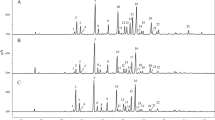Abstract
Thirty-one compounds are identified in the essential oil of Mexican bay (Litsea glaucescens var.glaucescens), which is dominated by 22.36± 2.19% 1,8-cineole, 13.03± 1.84% sabinene, and 10.09± 0.72% terpinen-4-ol. In contrast, the oil of Greek bay (Larus nobilis) is dominated by 41.70± 1.34% 1,8-cineole and 15.24± 2.95% α-terpinyl acetate. The yield of oil from Mexican bay leaves is about one quarter that of Greek bay. Mexican bay adds a bay-like note but is not a substitute for Greek bay. Pinocarvone and (E)-pinocarveol are reported for the first time in the essential oil ofL. nobilis.
Abstract
Trienta y uno componentes están identificados en el aceite esencial de las hojas de laurel mexicano (Litsea glaucescens var.glaucescens) que está dominado por cineol (10,09± 0,72%) y terpinen-4-ol (10,09± 0,72%). Al contrario, el aceite esencial de las hojas de laurel griego (Taurus nobilis) está dominado por cineol (14,70± 1,34%) y el acetato de α-terpineol (15,24± 2,95%). El rendimiento de aceite de las hojas de laurel mexicano es casi una cuarta parte del rendimiento de laurel griego. El laurel mexicano suma una nota de hojas de laurel pero no es un sustituto para el laurel griego. Pinocarvona y (E)-pinocarveol están anunciados por primera vez en el aceite esencial deL. nobilis.
Similar content being viewed by others
Literature Cited
Akgül, A., M. Kivanç, andA. Bayrak. 1989. Chemical composition and antimicrobial effect of Turkish laurel leaf oil. J. Essential Oil Res. 1:277–280.
Allen, C. K. 1945. Studies in the Lauraceae, VI. Preliminary survey of the Mexican and Central American species. J. Arnold Arbor. 26:365–434.
Anaç, O. 1986. Essential oil contents and chemical composition of Turkish laurel leaves. Perfumer & Flavorist 11 (5):73–75.
Boelens, M. H., andR. J. Sindreu. 1986. The chemical composition of laurel leaf oil obtained by steam distillation and hydrodiffusion. Pages 99–110in E.-J. Brunke, ed., Progress in essential oil research. Walter de Gruyter, Berlin.
Buttery, R. G., D. R. Black, D. G. Guadagni, L. C. Ling, G. Connolly, andR. Teranishi. 1974. California bay oil. I. Constituents, odor properties. J. Agric. Food Chem. 22:773–777.
Goryaev, M. I., N. A. Kekelidze, G. I. Krotova, T. E. Serkebaeva, andA. D. Dembitskii. 1967. Essential oil composition. XXVII. Analysis of the high boiling fraction of noble laurel essential oil. Izv. Akad. Nauk. Kaz. SSR, Ser. Khim. 17 (5):78.
Hokwerda, H., R. Bos, D. H. E. Tattje, Th. M. Malingré. 1982. Composition of essential oils ofLaurus nobilis, L. nobilis var.angustifolia and L.azorica. Pl. Med. 44:116–119.
Kekelidze, N. A. 1966. Essential oil composition. XXVI. Leaves and stems ofLaurus nobilis. Izv. Akad. Nauk Kaz. SSR, Ser. Khim. 16 (4):86–91.
Kennedy, D. 1990. Mexican regional cooking. Rev. ed. Harper Collins Publ., New York.
Lawrence, B. M. 1979. Chemical evaluation of various bay oils. Pages 29–49in B. M. Lawrence, ed., Essential oils 1978. Allured Publ. Corp., Wheaton, IL.
Martinez, M. 1969. Las plantas medicinales de Mexico. 5th ed. Mexico.
Pertoldi Marietta, G., andB. Stancher. 1968. Sulla carotterizzazione delle spezie olei essenziale di alloro. Atti. Congr. Qual. 6th 1967:303–320.
Pruidze, V. G., S. G. Tukvadze, andN. A. Kekelidze. 1971. Change in essential oil during storage of Grecian laurel leaves. Trudy Gruz. Nauch.-Issled. Inst. Pisch. Prom. 5:151–155.
Standley, P. C. 1920–1926. Trees and shrubs of Mexico. Contrib. U.S. Natl. Herb. 23:1–1721.
Tucker, A. O., M. J. Maciarello, R. P. Adams, L. R. Landrum, andT. A. Zanoni. 1991. Volatile leaf oils of Caribbean Myrtaceae. I. Three varieties ofPimenta racemosa (Miller) J. Moore of the Dominican Republic and the commercial bay oil. J. Essential Oil Res. 3:323–329.
Zola, A., J. P. Le Vanda, andF. Guthbrod. 1977. L’huile essentielle de laurier noble. Riv. Ital. Essenze Profumi Piante Off., Aromat., Syndets, Saponi, Cosmet., Aerosols 59:374–378.
Author information
Authors and Affiliations
Rights and permissions
About this article
Cite this article
Tucker, A.O., Maciarello, M.J. & Hill, M. Litsea glaucescens Humb., Bonpl. & Kunth var.Glaucescens (Lauraceae): A Mexican bay. Econ Bot 46, 21–24 (1992). https://doi.org/10.1007/BF02985250
Received:
Accepted:
Issue Date:
DOI: https://doi.org/10.1007/BF02985250




